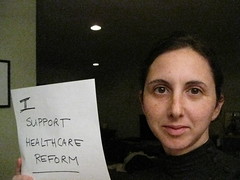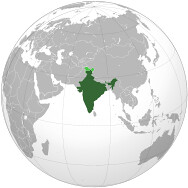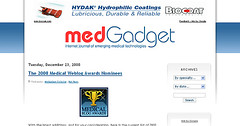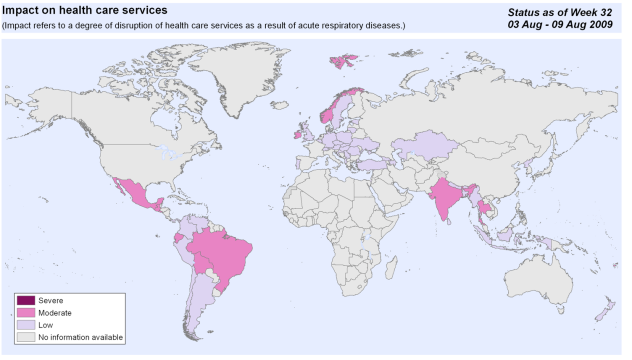15 December, 2009
09 December, 2009
Modern contraceptives in India

Recently, Birth control ring NuvaRing was recently (December2009) launched in India by Organon (India).
NuvaRing is a flexible, transparent ring containing hormones that are dispersed throughout the ring’s core and absorbed through the vaginal lining directly into the bloodstream, when inserted. The exact positioning of the ring is not critical for it to work. Additionally, the ring works, like ‘the Pill’, by inhibiting ovulation. In order to prevent pregnancy for a full month, NuvaRing must be inserted and left in place for three consecutive weeks. After a one week ring-free interval, a new ring must then be inserted in order to have continued contraceptive effect.
08 December, 2009
Social Media in Public Health
29 November, 2009
Empathy in Medical Education
It lets you create an online collection of research papers
Organize, share, and discover research papers! Mendeley is a research management tool for desktop & web. You can also explore research trends and connect to other academics in your discipline.
16 November, 2009
13 November, 2009
Healthcare reform supporters from Rural Medical center

We are supportive of health reform and this bill is a step in the right direction.
- The proposed insurance reforms are long overdue. All people regardless of health status deserve fair coverage.
- Shared responsibility is critical to the success of meaningful reform. Younger adults with lower health risk should not be able to opt out without a penalty.
- Assistance to small business is a big plus. Especially in smaller communities like Austin and our surrounding area where future economic growth is highly dependent upon entrepreneurs. When these new businesses grow to a self-sustaining size, they’ll be able to pay their fair share of health costs. Giving them an exemption during the early years is the right thing to do.
- We do not support a public option modeled after Medicare. Today, government-run insurance programs can be heavy-handed, bureaucratic, inefficient systems that penalize medical systems (like AMC) that offer high value care. We cannot assume this public option will be any different. Our fear is that this plan will morph into a federal fixed fee schedule that is priced below our costs. This could drive all private insurance out of the market and we could end up with a government-run system like Great Britain and Canada. While these systems handle public health well, those that are very sick get rationed care. Most Americans will find rationing intolerable. We prefer to see expanded coverage through an insurance exchange like the Federal Employees Health Benefit Plan model, which Members of Congress and all federal employees have. This exchange offers multiple private plan choices and is the best “public option” for offering insurance for all.
09 October, 2009
Introduction to medical ethics
Here are notes on "Introduction to Medical ethics"
05 October, 2009
Healthy lifestyle benefits-
16 September, 2009
Change in Health education apparatus in India

To overcome the acute shortage and uneven distribution of human resources in public health delivery system, the Ministry of Health & Family Welfare aims at overhauling the current regulatory framework. Toward this end, it is proposed to set up a National Council for Human Resources in Health as an overarching regulatory body to achieve the objective of enhancing the supply of skilled personnel in the health sector.
http://www.mohfw.nic.in/nchrc-health.htm
11 September, 2009
Swine Flu Update: Single-Dose Vaccine Appears to Work
 The first clinical trial data on new vaccines being developed to treat the H1N1 pandemic flu virus in the U.S. suggest that one dose will work to immunize most people, according to a preliminary report in the New England Journal of Medicine.
The first clinical trial data on new vaccines being developed to treat the H1N1 pandemic flu virus in the U.S. suggest that one dose will work to immunize most people, according to a preliminary report in the New England Journal of Medicine. 05 September, 2009
WHO: Impact on healthcare services
27 August, 2009
Using Cellphones to diagnose Malaria and Blood disorders
 Microscopy provides a simple, cost-effective, and vital method for the diagnosis and screening of hematologic and infectious diseases.It is an essential tool in disease diagnosis and widely used all over the world. Unfortunately, the EXPERTISE required to use the tool, and to evaluate the findings is not very common. One requires a pathologist with many years of experience to make sense of those seemingly random and confused pixels. (I know, i am a pathologist :-)
Microscopy provides a simple, cost-effective, and vital method for the diagnosis and screening of hematologic and infectious diseases.It is an essential tool in disease diagnosis and widely used all over the world. Unfortunately, the EXPERTISE required to use the tool, and to evaluate the findings is not very common. One requires a pathologist with many years of experience to make sense of those seemingly random and confused pixels. (I know, i am a pathologist :-)
It takes a lot of effort, and money to train a pathologist, equip him/her with all the instruments required, and then use the skills in a backward area without proper facilities. But the advent of digital imaging has solved many of our troubles. Telepathology made sure that we do not need a pathologist physically present at the site, to render a diagnosis. But microscopy and digital imaging of the biopsy/tissue fragment was still a hassle. Now we have done better. You don't even need a microscope to send a microscopic image over the network!! Researchers from the Univ. of California worked with high-powered LED – which retails for just a few dollars – coupled with a typical camera phone to produce a clinical quality image sufficient for detecting in a field setting some of the most common diseases in the developing world.
The newly developed technology, CellScope, allows for average cell cameras to be retrofitted with powerful microscopes, able to detect malaria parasites, and even fluorescent marker-stained tuberculosis bacteria.
Thus you have your humble cell-phone transformed into the sherlockian "cell-scope".“The images can either be analyzed on site or wirelessly transmitted to clinical centers for remote diagnosis. The system could be used to help provide early warning of outbreaks by shortening the time needed to screen, diagnose and treat infectious diseases,” University of California in San Francisco (UCSF)/UCB Bioengineering Graduate Group graduate student David Breslauer adds. CellScope could also provide remote access to digitized health records, and would be amenable to epidemiological studies, using triangulation or global positioning system location data, such that outbreaks could be monitored as they happen.
 So maybe i could click a photomicrograph of that mole on my friend"s forearm, twitter it to my onco-pathologist friends, who view it on their smartphones and twitter / message their diagnosis back to me. Simple and fast, especially with my own group of pathologists on the network.
So maybe i could click a photomicrograph of that mole on my friend"s forearm, twitter it to my onco-pathologist friends, who view it on their smartphones and twitter / message their diagnosis back to me. Simple and fast, especially with my own group of pathologists on the network. Related articles
Kindle in Medicine

- Easy for medical students to keep up with all their scheduled reading. You can download and read reference materials that you have read previously to refresh your memory.You can seek out new textbooks to look for answers too.
- Seeking out symptoms, conditions, and other relevant information is easy.You can view photos on the Kindle if you need to see pictures of various signs and symptoms conditions.
- Study medical texts and highlight portions of texts / make notes on the Kindle as you go. Zoom into images for micro details.Bookmark and annotate important portions.
- Research can be done on its built-in web browser ( experimental feature) , no need to carry a laptop to access the internet.It offers free Wireless access to Wikipedia
- .Multiple books can be read at once, no need to carry a JUMBO Grey"s anatomy or Robbin"s Pathology encyclopedias !! It boasts of storage capacity of 1500 / 3500 books, depending on the Model.
- You can listen to music while you read.
- Inbuilt Text-to-Speech feature lets you listen to your favorite books.
Also , many more wireless features ( like chat, email, videos etc) need to be added. If more such functionality is added to justify its high prices, i expect a LARGE number of medical students turning to Kindle.
18 August, 2009
New Swine Flu Guidelines
The patients have been categorized as follows:
- Category A: Patients with mild fever plus cough/sore throat with or without body ache, headache, diarrhoea and vomiting. They do not require Oseltamivir and should be treated for the symptoms mentioned above. The patients should be monitored for their progress and reassessed after 24 to 48 hours by the doctor. No testing of the patient for H1N1 is required. Patients should confine themselves at home and avoid mixing with the public and high risk members in the family.( I agree with this)
- Category B: (i) In addition to all the signs and symptoms of Category A, if the patient has high grade fever and severe sore throat, he/she may require home isolation and Oseltamivir; (ii) In addition to all the signs and symptoms of Category A, individuals having one or more of the following high risk conditions shall be treated with Oseltamivir: children under five, pregnant women, those above 65 years, those with lung diseases, heart disease, liver disease, kidney disease, blood disorders, diabetes, neurological disorders, cancer and HIV/AIDS; Patients on long term cortisone therapy. No H1N1 tests are required for Category-B (i) and (ii). Such patients should confine themselves at home and avoid mixing with the public and high-risk members in the family.( I think all such cases be tested for H1N1, and antiviral therapy started without delay)
- Category C: In addition to the symptoms of Categories A and B, if the patient has one or more of the following: breathlessness, chest pain, drowsiness, fall in blood pressure, sputum mixed with blood, bluish discolouration of nails; irritability among small children, refusal to accept feed; worsening of underlying chronic conditions. Such patients require testing, immediate hospitalisation and treatment.( All such patients should be started on antivirals without even waiting for test results!!, its already late!!)
During the meeting, various guidelines and protocols developed by the World Health Organisation, Geneva, the Centre for Disease Prevention and Control, Atlanta, United States, and the National Health Service, United Kingdom, were also discusse

30 July, 2009
Medical consultation on the Move

A new mobile handheld technology developed by mVisum of Cedar Brook, NJ, is been tested. This communication tool boasts of providing off-site cardiologists access to EKGs that can then be used to prescribe immediate treatment.
The Department of Veterans Affairs is testing this new system which seemingly enables fast transfer of clinical data to a smartphone for review within minutes. The mVisum Medical Communication System is stated to be a communication tool which permits health-care personnel to securely receive, review and respond to a patient"s medical data recorded at the point of care. This transfer of information notably takes place through secure HIPAA compliant internet servers, later transmitting it via mobile technology to the smartphone of the physician. More so, this system is also loaded with the ability to be availability aware, so that the patient can refer to another physician in the absence of the original intended physician. The various types of medical data that can be sent through this technique include DICOM images, EKGs, CT scans, MRIs, X-rays, etc. Along with this, textual information relating to the patient may also be included in the message for the purpose of getting a broader idea about the condition of the patient.
The process begins with the recording of patient data at the point of care. Point of Care can include the physician's office, medical center, hospital, or anywhere the patient is located and an system is installed.Data is transmitted securely and reliably to the physician's mobile handheld device. The system has advanced technology that allows the system to be availability aware,so that another physician can immediately be contacted if the original intended physician is unavailable.Once received, the physician can review data and securely respond with medical opinion, prescription or other critical orders.

29 July, 2009
Mobile phones for public health
Here’s a video (via MobileActive.org) that showcases Nokia’s Data Gathering application for the E71. The video shows the Amazonas’ State Health Department in Brazil using the devices and application to monitor and treat outbreaks of dengue fever. In developing markets one of the key problems for caregivers and public health workers is recording and managing data collection on health issues for large populations. The application featured below shows the type of technology replacing the clipboard abroad, but similar technologies are being deployed across hospitals in the U.S. like mobile clinical assistants (MCA) that sync up to a hospital’s EMR.
30 June, 2009
Have Sex every day, Doctors advice.
LONDON (Reuters) - Having sex every day improves the quality of men's sperm and is recommended for couples trying to conceive, according to new research.
Until now doctors have debated whether or not men should refrain from sex for a few days before attempting to conceive with their partner to improve the chance of pregnancy.But a new study by Dr David Greening of Sydney IVF, an Australian center for infertility and in vitro fertilisation (IVF) treatment, suggests abstinence is not the right approach.
He studied 118 men with above-average sperm DNA damage and found the quality of their sperm increased significantly after they were told to ejaculate daily for seven days.
On average, their DNA fragmentation index -- a measure of sperm damage -- fell to 26 percent from 34 percent, Greening told the European Society of Human Reproduction and Embryology in Amsterdam on Tuesday.
Frequent sex does decrease semen volume but for most men this is not a problem.
"It seems safe to conclude that couples with relatively normal semen parameters should have sex daily for up to a week before the ovulation date," he said in a statement."In the context of assisted reproduction, this simple treatment may assist in improving sperm quality and ultimately achieving a pregnancy."
Greening said it was likely frequent ejaculation improved the quality of sperm by reducing the length of time they were exposed to potentially damaging molecules called reactive oxygen species in the testicular ducts.
25 June, 2009
India needs IT based health delivery system

The Columbia University Professor, while praising India's effort for closing gap on the health mission under the Millennium Development Goals (MDG) with the other countries, however, said that the country needs to make more investment in the sector. "India should step up the budgetary allocation in health sector to four to five per cent of the GDP," Sachs said adding that a higher investment in the health sector will give great social returns.Calling the NRHM as one of the most remarkable achievements in public health sector, he said that India's dramatic improvement in the health sector have been made possible due to enhanced partnership between the centre, state and local units.
Sachs, who is also the advisor to UN Secretary General Ban Ki Moon, said that the increase in institutional delivery and drop in mortality is especially impressive.
Arguing for an IT-based health delivery system, Sachs added that India can serve as a role model for other countries in the health sector.Having traveled to a few Indian states, he also said that there is, however, a need for more human resources and logistical support.
26 April, 2009
Health care reforms in the US.
 By Sanch Panza on Flickr
By Sanch Panza on Flickr Health care reform is a hot topic these days. What is health care reform? The President, Congress and people like you are talking about it. The simple answer is well, there is no simple answer.
A few ways to reduce healthcare costs include
- More Use of Technology
- Empower people with More information
- Payment to care providers to be based on Quality rather than the number of investigations performed. ( This is very basic actually)
- Promote healthier Lifestyle.

02 April, 2009
Medical Animations - WebSlides
A clickable list of my favorite 3D animation sites in Medicine.
28 March, 2009
The male foreskin is dangerous- Circumcision protects .
In 2007, the ethical landscape surrounding medical male circumcision (MC) suddenly lurched and shifted when the World Health Organization and UNAIDS declared unequivocally that the `efficacy of male circumcision in reducing female to male transmission of HIV has been proven beyond reasonable doubt.The male foreskin has been shown to have a high number of cells that were targeted by the HIV virusResearchers have even found that MC reduces the risk of cervical cancer in current female partners . In spite of that growing list of medical benefits, the issue has hovered just below the radar screen until several large randomised controlled studies from Africa showed that circumcision offered a 60% to 70% protective effect against the heterosexual acquisition of HIV. The evidence was so compelling that three of the studies were stopped early, on the recommendation of Data Safety and Monitoring Boards
Interestingly, evidence that MC had medical benefits has been mounting for more than 20 years. Not only does the procedure reduce the risk of HIV infection, it also has been shown to prevent urinary tract infections, sexually transmitted diseases, and penile and prostate cancers.
The Government of India has been reluctant to approach an issue that promises to be controversial among conservative Hindus. MC is considered a marker of religious identity since Muslims routinely circumcise their male children, and Hindus do not. It has been suggested that at times, circumcision status may even have been used to identify people`s religious affiliation during communal riots. Popular wisdom holds that even the mention of MC in some communities will trigger sectarian violence. Predictably, some opponents have argued that the greater good of society must be protected by withholding information about MC from the population.
This is a joke, surely?
They wont tell the benefits of circumcision because they want to use it to identify Muslims?

Other proofs of advantages of circumcision
Removal of the foreskin of the penis (male circumcision, MC, C) is known to significantly reduce female-to-male HIV transmission through sex, which then decreases male-to-female transmission. Three recent randomized controlled studies from Africa have shown that circumcision offers a 60% to 70% protective effect against heterosexual acquisition of HIV. The protective effect of circumcision against HIV, known since the 1980s, has been confirmed by more than 30 studies before these three famous randomized controlled trials, which are the criterion standard of clinical research.
09 March, 2009
-Distance education in Medical and paramedical sciences
 Image by interplast via Flickr
Image by interplast via Flickr
Distance education is a relatively new concept which not only has the ability to train a large number of health care workers in a short time in a cost effective way but can also attend to skills of health care without diluting the quality.Distance teaching-learning often involves a multi-media approach to design, develop and implement independent learning programs through self-instructional materials, both in print and electronic media forms. Distance study allows self pacing for convenience and also facilitates learners having control over their learning. The various media used for distance education delivery include among others, print materials, audio and video programs, radio and television programs, tutoring and counseling, field visits, laboratory practicals, extended contact programs, and teleconferencing.
The following issues need to be addressed and considered for successful application of distance education programs for health professions:
1. Since health sciences deal with life and death and are therefore are more skill-oriented (rather than more knowledge-based), it is felt that providing basic beginning or early training in the field of health may not be feasible through distance learning. Being an innovative and flexible system, and having the ability to respond to emerging training and educational needs, distance education is more appropriate for inservice training of health personnel.
2. The academic programs have been confined to a limited area of health education and training. In order to meet the diversified and emerging needs of health workers, the programs and courses have to go beyond medical graduates to include a wide variety of need-based functional areas ranging from simple awareness programs to more complicated skill-oriented courses on epidemiology and health economics.
3. Application of sophisticated communication technology has to be done cautiously, keeping in view clients needs, cost, media behavior and infrastructure and facilities at the receiving end. In the developing countries including India, audio and television programs seem to be more feasible and promising. Furthermore, multi-media packages need to include a large amount of hands-on and field experience.
4. An issue to be deliberated is the provision of student support services for health workers and professionals. While compulsory counseling and extended contact increase the effectiveness of programs, these on the other hand pose problems to both providers as well as the receivers of health education. More practical-oriented courses need to have compulsory built-in face-to-face components; and work centers or practice centers at grassroots level with required instructional provisions would be more feasible than regular study centers.
In conclusion, it is worth noting that distance education has tremendous potential for providing education and training programs to different categories of medical and paramedical personnel as a means of helping achieve the goals of HFA. In addition to the national agencies such as the Ministry of Human Resources Development, the Ministry of Health & Family Welfare and Indira Gandhi National Open University, international agencies such as WHO and UNICEF need to play increasingly prominent roles in facilitating the achievement of national and institutional targets. Proper use of ISRO provided satellite communication facilities can make distance education courses an important aspect of ongoing medical education.
17 February, 2009
-New test to say if dengue vaccine is safe
"Our stNew test to say if dengue vaccine is safeudy shows that the new test is likely superior to the standard test in its ability to tell whether a patient's response to a vaccine is safe," Associate Professor of Medicine at the University of Rochester Medical Centre (URMC) and co-author of the study Xia Jin said.
Cases of tropical, mosquito-borne dengue fever have been expanding globally for more than 50 years, with nearly a third of the human population in 100 countries now at risk of infection with the four types of dengue virus.
Infection with the dengue flavivirus, which is related to West Nile Virus and Yellow Fever, annually results in an estimated half a million hospitalisations and 22,000 deaths, mostly among infants, according to World Health Organisation (WHO).
After decades of absence in the US, the disease is causing illness again along the Texas-Mexico border, experts say and add that widespread dengue infection in the continental US is a real possibility, reports IANS.
A typical dengue infection confines a patient to bed for more than a week with fever and severe limb pains, but most recover. In less than five per cent of cases, however, dengue hemorrhagic fever (DHF) and dengue shock syndrome (DSS), often deadly complications, develop just as the fever breaks.
Mostly affecting babies between five and eight months, DHF causes victims to vomit and pass blood in their feces and urine. If diagnosed quickly, patients respond to intensive hospital treatment and fluids, but mortality can reach 15 per cent when undiagnosed.
DSS comes when the infection has caused so much fluid to leak out of capillaries that there is not enough blood to supply organs. As of 2008, there were no antiviral drugs designed to treat dengue and no drug candidates in late-stage development, an URMC release said.
09 February, 2009
-Mobile healthcare in Punjab
 Image via Wikipedia
Image via Wikipedia
Chandigarh: In a bid to increase accessibility of the rural people for getting better healthcare, the Chandigarh Administration has started a Mobile Medical Unit (MMU) to provide healthcare services at the door steps of the rural people.
MMU not only facilitates access to basic services of healthcare, but also provides essential knowledge and information on the kind of services under the umbrella of National Rural Health Mission (NRHM).
The Unit, a hospital on wheel under the flagship programme of NHRM, has been pressed into service in the union territory (UT) as joint venture with the Guru Granth Sahib Sewa Society.
A team consisting of eye specialist, gynaecologist and dentist will provide specialist services from within the van. Two doctors of Health Department along with RCH staff will provide primary health care facilities including MCH and immunisation services.
Initially, 10 villages have been identified which will be visited by the team fortnightly.
Information, education and communication (IEC) material on health education including personal hygiene, proper nutrition, hazards of tobacco consumption would be displayed and health awareness about various ongoing national programmes will be imparted.
04 February, 2009
-Prozac- Things to know before you use it.
Prozac or ( Fluoxetine Hydrochloride ) is a commonly used antidepressant in clinical practice. It has shown excellent results and is often used by people/patients even without proper prescriptions. Is that safe??
Below is a slideshow i have prepared detailing a few important facts about Prozac use. Also incorporated is a video which will further enhance comprehension about this widely used drug.
02 January, 2009
-Human rights abuses contribute to Malaria
Human rights abuses contribute to malaria
Medecins Sans Frontieres recently listed 10 top crisis areas that highlight in many instances the interrelation between human rights abuses and poor health. Recent news on two of these areas, Zimbabwe and Burma, shows even stronger links to malaria.ZWNews quotes an IRIN report: “‘There is no food, we have malnutrition, there is cholera, now we are expecting a malaria outbreak,’ said an exasperated Amanda Weisbaum, the emergency manager for Save theChildren, UK, in Zimbabwe.” After suffering cholera and malnutrition, “With the onset of rain, there are mounting concerns of a possible malaria outbreak ravaging immune systems weakened by cholera and malnutrition, ‘especially among those aged under five,’ said Weisbaum.”The government even recognizes the threat of the rainy season. The Herald reports that …
recently listed 10 top crisis areas that highlight in many instances the interrelation between human rights abuses and poor health. Recent news on two of these areas, Zimbabwe and Burma, shows even stronger links to malaria.ZWNews quotes an IRIN report: “‘There is no food, we have malnutrition, there is cholera, now we are expecting a malaria outbreak,’ said an exasperated Amanda Weisbaum, the emergency manager for Save theChildren, UK, in Zimbabwe.” After suffering cholera and malnutrition, “With the onset of rain, there are mounting concerns of a possible malaria outbreak ravaging immune systems weakened by cholera and malnutrition, ‘especially among those aged under five,’ said Weisbaum.”The government even recognizes the threat of the rainy season. The Herald reports that …HARARE City Council has embarked on a programme to
clear stormwater drains with the assistance of residents under the
food-for-work programme at a time the United Nations Children’s Fund
has contracted trucks to speed up the removal of refuse in the city as
a measure to curb the spread of malaria and cholera.Under the
programme, residents in high-density suburbs are paid for clearing the
drainage systems in their respective areas.
A BBC reporter notes that, “The country that was once the jewel in Africa’s crown, able to feed itself, heal its sick and educate its people to the highest standards on the continent, is now in a pitiful state.” The BBC has been showing the link between Zimbabwe’s current problems and its
human rights violations that contributed to the present economic, political and health crises.
In eastern Burma “Access to maternal health-care is extremely limited and poor nutrition, anemia and malaria are widespread in eastern Burma, which increases the risk of pregnancy complications,” was a finding of researchers from the Johns Hopkins University, as reported in Medical News Today. The full article in PLoS Medicine reported that, “Few women had received iron supplements or had used insecticide-treated bednets to avoid malaria-carrying mosquitos.
Consequently, more than half the women were anemic and 7.2% were infected with malaria parasites.”
receiving any antenatal care.”
A disregard for human rights and a breakdown of health services, especially for the most vulnerable, appear to go hand in hand. Another call for peace in 2009 is urgent.
01 January, 2009
- The best medical blogs of 2008.
My blog drneelesh@Raksha has made it to the Final list of Nominees as Best NEW Medical blog of 2008.. At stake is the title and a PDA. In all, Fifteen entries were chosen as the final nominees in this category..Other categories include Best Clinical sciences,
 Image by drneelesh via Flickr Health policies,Best blog on Medical ethics, Best Literary Medical, Health IT, Patient centered, e.t.c. Now the final "awardees" will be chosen via an internet voting system. All you have to do to vote is scroll to the bottom of the nomination-list page and write in a comment here about my blog or simply second my blogs nomination.
Image by drneelesh via Flickr Health policies,Best blog on Medical ethics, Best Literary Medical, Health IT, Patient centered, e.t.c. Now the final "awardees" will be chosen via an internet voting system. All you have to do to vote is scroll to the bottom of the nomination-list page and write in a comment here about my blog or simply second my blogs nomination.My Blog looks at Medical issues from the eyes of a pathologist , e.learning enthusiast and a Health Rights pro-activist. My page may take some time to load ( the left half of the page is slightly data heavy, but be patient. The wait will be worth it!).There are a number of ways to interact with me. You can also search my virtual library (my references, bookmarks,images,articles,blogs, etc). via this website.
So do check out my blog and don't forget to comment on Medgadget.com. I would love to get my hands on this piece of electronics.
M.B.B.S (AFMC),M.D (Path)
P.G.P in Human Rights
Chief Mentor ( RAKSHA)
Registered society for knowledge and health activities.






![Reblog this post [with Zemanta]](http://img.zemanta.com/reblog_a.png?x-id=438b76b8-e781-449a-a28e-3733a9f96476)

![Reblog this post [with Zemanta]](http://img.zemanta.com/reblog_e.png?x-id=c2c695f8-143f-4042-b02f-42ead7b94afb)
![Reblog this post [with Zemanta]](http://img.zemanta.com/reblog_a.png?x-id=646dc71d-788f-4695-9f07-e7221a30e0ab)
![Reblog this post [with Zemanta]](http://img.zemanta.com/reblog_a.png?x-id=e89afc19-7359-4b21-849b-48d6fe86ff44)
![Reblog this post [with Zemanta]](http://img.zemanta.com/reblog_a.png?x-id=3bad9a48-972d-469f-acbe-58710c5883e4)
![Reblog this post [with Zemanta]](http://img.zemanta.com/reblog_a.png?x-id=eb6230c2-0319-4046-9b87-c869252c47be)